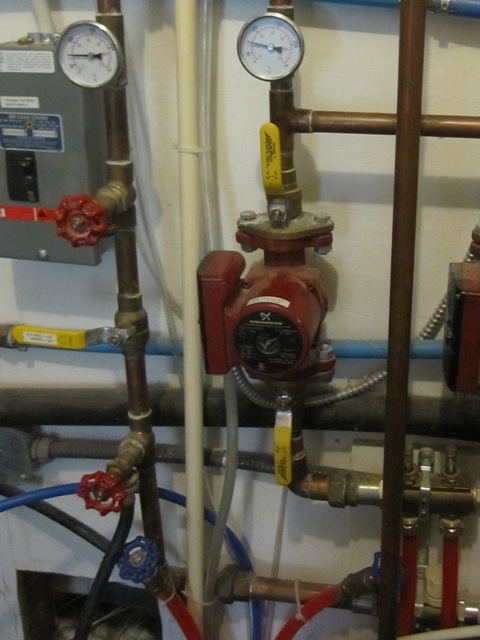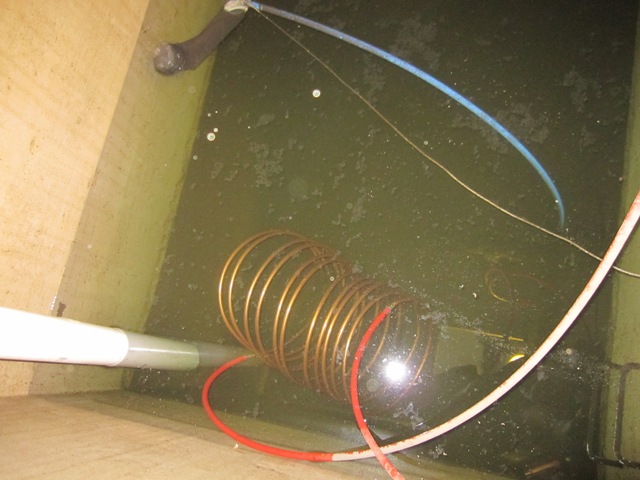July 15, 2012
We installed our original cooling system in July 2010 and it has worked reasonably well, but over the last few weeks we’ve had a hot spell with daytime temperatures mostly in the upper 90’s and well over 100 degrees Fahrenheit for a few days. That’s normal in some parts of the world but in Michigan, we consider that HOT! Over two weeks of unusually hot weather the house reached 77 degrees at the warmest point when it was 105 outside, which is actually pretty good since we’re cooling the entire house for about 30 cents per day, but 77 degrees inside is a bit warmer than we would like and we anticipate more hot weather to come. The original cooling system circulated water through the radiant floor slabs and through a copper coil heat exchanger in one half of the cistern, so we decided to add a second heat exchanger in the other half of the cistern in order to increase the capacity of the system, both in terms of power (BTU/hour) and total heat capacity (BTU).
The first order of business was to improve the plumbing in the mechanical room. Previously I just connected the cistern loop with hoses connected to the drain and fill valves of the hydronic heating (now cooling) plumbing. This connection worked okay but it was only meant to be temporary and probably restricted the flow rate somewhat as the water had to flow through the drain/fill valves. So, I disassembled the copper piping and added two T fittings for direct connections to the cistern cooling loop. I also relocated one of the temperature gauges so that I can directly measure the temperature of the water returning from the floor slabs. This will permit a more accurate measurement of the system’s performance. The photos below show the plumbing before and after this change. The vertical red 5/8″ PEX tubing runs to the heat exchangers in the cistern. Water returns from the floor slabs through the manifold at the very bottom of the photo, then flows up through the temperature gauge and then out the lower T fitting and down to the cistern. It returns through the long red tube that’s visible in the photo, into the upper T fitting and then up and around to the circulator pumps and back out to the floors through the upper manifold. This is essentially the same as it was before except that it’s now a permanent connection, with the temperature gauge moved down to the warm side of the loop so I can directly measure the temperature drop across the heat exchangers. In the winter we’ll close the two valves to the cistern lines and open the one in the middle, so the heating water won’t flow through the cistern loop.


After the plumbing in the mechanical room was redone, I opened up the cistern to add a second heat exchanger. This was the first time we had opened it in about 2 years, so it afforded a good opportunity to examine the clarity of the water. Since we’ve had a hot, dry spell for the last 4 weeks we have been using a lot of cistern water for the gardens, and we’re down to about 36 inches or 4,300 gallons, out of a total capacity of 12,000 gallons. Hopefully we’ll get some significant rain soon to replenish our irrigation water supply, but we can refill it from the well if necessary.
The first photo below shows the first (north) half of the cistern where the rainwater enters through the white pipe in the lower left of the photo. The copper coil is the heat exchanger that I installed 2 years ago for the original cooling system. The camera’s flash exaggerates the small amount of material floating on the surface, some of which fell down when I opened the hatch. You can see that the bottom is covered in dark sediment, which is not surprising since this side receives water from the roof. I didn’t climb down far enough to measure the sediment but it appears to be less than 1/8 inch thick. This will have to be cleaned out someday, but probably not for quite a few years. The second photo shows the new heat exchanger coil in the second (south) half of the cistern. It’s quite striking how much cleaner the water is on this side, because most of the sediment settles out on the first side before water flows by gravity through the floating filter (visible at the upper left of the first photo) and into the second side. We pump water out through another floating filter (not visible) in the second side where the water is cleanest. There is a 5-micron filter attached to the cistern pump in the mechanical room, and after nearly 3 years of operation we still haven’t needed to change the filter cartridge because there is almost no sediment in the water coming from the second half of the cistern.


The two heat exchanger coils are connected in parallel through T fittings as shown in the photo below, so that the water splits and flows through both of them together rather than flowing first through one and then the other. This will transfer approximately the same amount of heat into both halves of the cistern, and more importantly it should offer considerably less flow resistance than if they were connected in series so we should get a higher flow rate using the same amount of energy to run the pumps as before.

In the first post on our cooling system about 2 years ago, I reported that the system had a flow rate of 1.8 gallons per minute on the low-speed pump setting, and had a 5 degree temperature drop through the single heat exchanger in the cistern. That gave us an Energy Efficiency Rating (EER) of34, which is about 3 times as efficient as a good air conditioning system. After improving the plumbing in the mechanical room and adding the second heat exchanger, I measured a flow rate of 2.6 gallons per minute on the same low-speed pump setting and a 6-degree temperature drop. This increases our efficiency by 73% for an EER of about 60, which is 5 times as efficient as a good air conditioner. Using only 120 watts of electricity to run the pumps, the system is removing about 2300 watts of heat energy from the house. It can’t sustain this rate indefinitely because the cistern water will warm up until it reaches equilibrium with the rate of heat transfer into the earth through the cistern floor and walls, so I expect the efficiency to drop a little over the next week or two. But it’s still many times more efficient than the best available air conditioning systems and heat pumps. Its total cooling capacity is very small however, so it is practical only because our total cooling load is very small due to the extreme level of insulation in the house, because our south-facing windows have carefully designed overhangs that block direct sun in mid summer, and because we use very efficient appliances that add very little additional heat to the house.